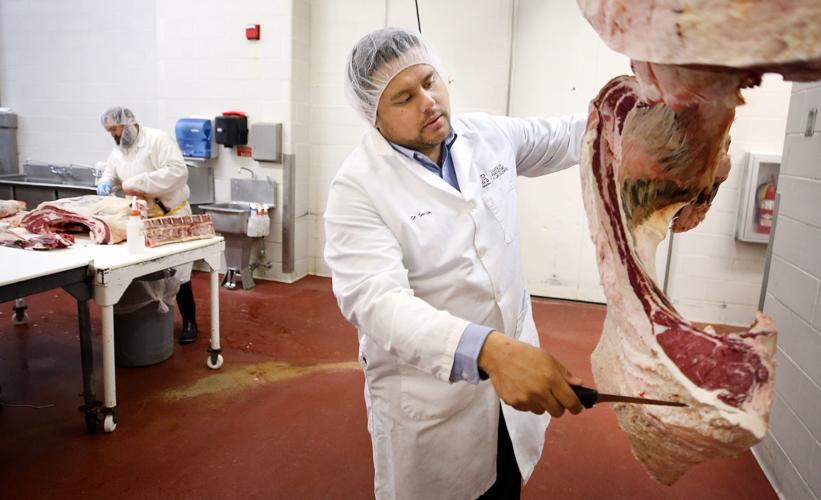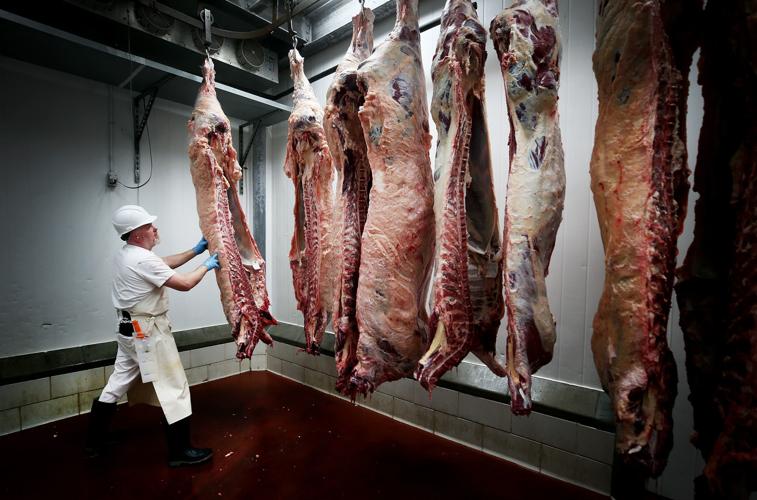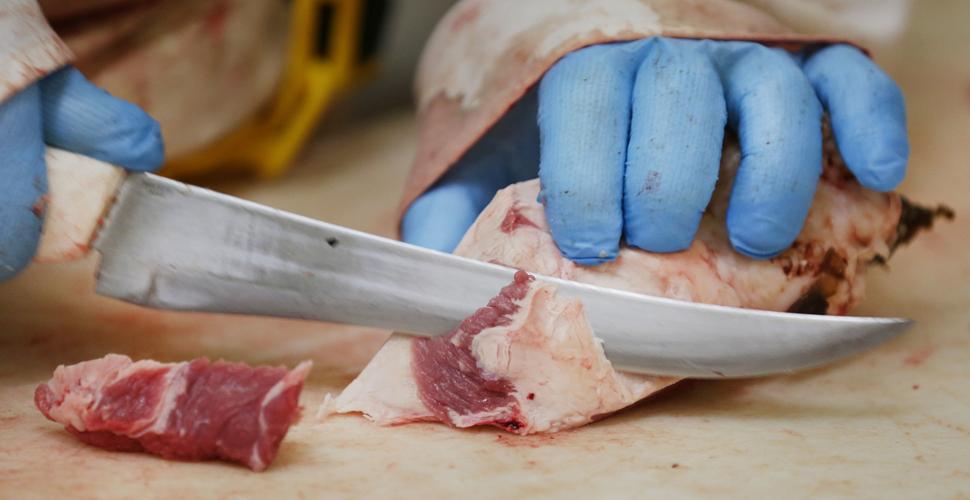How many scientists does it take to make the perfect steak? That might seem like an odd question, but meat production is a complicated industry that has more science behind it than most people realize.
Raising a four-stomached animal that weighs upward of 1,000 pounds takes a surprising amount of knowledge. And what do you do when it is time to slaughter your behemoth bovine? Well, if your ranch is near УлшжжБВЅ you can check out the University of УлшжжБВЅтs тmeat laboratoryт on North Campbell Avenue. Finally, you need to cook that meat, which expert chefs will tell you comes down to chemistry.
But you donтt have to go back to school to learn the ins-and-outs of meat management. The meat experts around town are more than happy to share the tricks of the trade.
Ranchers тneed to be relaxedт
The masters of meat agree that the best beef comes from calm, healthy cows. This is because stressed cattle tend to have more health issues, which can lead to a variety of problems with the growth of the animal, according to Coby Reid, a sixth-generation rancher who now advises other ranchers on feeding and breeding issues with Cedar Point Ranch Consulting in Gilbert.
People are also reading…
тWhen handling cattle you need to be relaxed and reduce stress as much as possible,т said Reid.
According to the United States Department of Agriculture (USDA) there is wisdom in Reidтs words. Stressed cattle require more antibiotics and grow more slowly than their nonstressed counterparts. Stress-related diseases actually cost cattle producers an estimated $500 million per year, according to a 2013 article in USDAтs Agricultural Research Magazine.
Gary Hickey, the executive chef-partner at Charro Steak in downtown УлшжжБВЅ, said that the ranchers he works with have developed some interesting techniques for avoiding stress in their animals.
тIf you approach the cattle you have to be on horseback so it is animal-on-animal interaction,т said Hickey. тIt keeps those stress levels down, keeps bad hormones super-low in the animal.т
There is more to the cattle-rearing puzzle than keeping cows calm, though. Diet and exercise also affect meat quality.
The problem is that the digestive system of ruminants (mammals which have a four-compartment stomach, like cows) is amazingly complex. In fact, most ranchers employ someone with a Ph.D. in ruminant nutrition to manage the diets of their herd, according to Reid.
The stomachs of these bovines use specialized bacteria and other microbes to break down food. The four-compartment system helps cows extract nutrients out of foods that most animals cannot optimally process (like grasses).
Finding the right set of foods to maximize growth for a particular herd of cattle takes an in-depth understanding of their complicated stomach physiology.
тA lot of people have the perception that thereтs not a lot of education that goes into feeding cattle but itтs all about efficiency, so a lot of science goes into that,т Reid said. тYou want them to get marbled without just getting fat.т
This is because marbling т the amount of intramuscular fat in an animal т is one of the main factors in getting flavorful, juicy meat. Unfortunately, the intramuscular fat that makes meat so tasty goes hand-in-hand with the development of тexternal fat,т which is the fat just underneath the skin that makes that chewy strip on the border of your steak.
This relationship between the good, usable meat and the external fat is called the yield grade and is used along with marbling to assess the quality of meat, according to Reid. The U.S. Department of Agriculture considers meat with high marbling and low external fat to be ideal. These тprimeт cuts are the most profitable for ranchers.
Genetics also play an important role in producing good meat. For example, many people tend to associate the Angus breed with high-quality beef.
This is partly because there are dozens of genes in this breed that have been linked to growth and marbling. For example, Angus tend to have the right genes for feeding efficiency, meaning Angus cattle gain more weight by eating less food than other breeds.
Angus cattle also tend to marble well and produce flavorful meat which is why Charro Steak uses Red Angus cattle from the 6,200-acre Meyer Company Ranch in Montana, according to Hickey, who visits the ranch at least once a year.
Genes play a role in more than just meat quality, of course. Genetics can affect how well an animal fits a particular environment. Local ranchers must consider this when trying to find the right breed for their business.
Angus cattle, which originated in Scotland, are not necessarily the best breed for the hot and dry climate around УлшжжБВЅ. Their thick hides can cause overheating problems, they like to stay in flat, grassy areas, and they donтt eat much of the natural vegetation in the desert, according to Reid.
This is why some local ranchers are researching the viability of other breeds like the Criollo, which originated in northern Africa and southern Spain. But how does a rancher go about conducting this research?
TUCSONтS MEAT LABORATORY
One way is to work with the Food Products and Safety Laboratory of the UAтs College of Agriculture and Life Sciences, aka: тthe meat lab.т
Built in 1988, the lab is the only facility of its kind at a university in the Southwest. The meat lab researches all things meat, according to lab manager Samuel Garcia.
тIt can go all the way from the ranch, to harvesting, or even further if you look at economic impacts,т said Garcia, who holds a Ph.D. in meat science from the UA.
One of the main functions of the lab is to assist local ranchers and small companies with meat-related issues, including how well a certain breed might work for a rancher.
Criollo cattle, for example, are well-adapted to arid climates according to Flavie Audoin, the doctoral student at the meat lab who is leading a study on the breed at Dennis Moroneyтs 47 Ranch near McNeal.
тThe Criollo are more suited with this kind of environment,т Audoin said. тThey use the landscape in a wider way, they use more (feed spots) than other breeds, they are smaller so they have less impact on the soil. They donтt spend as much time near water, and they are able to marble well just on rangelands.т
Audoin, who traveled from France to do her Ph.D. work in УлшжжБВЅ, also said that preliminary data have found that the Criollo breed has a better ratio of omega-3 to omega-6 fatty acids than other cattle in the area.
While omega-6 fatty acid is common in American beef, omega-3s are relatively rare, according to Audoin. This suggests that Criollo beef could potentially be a good source of these fats, which are beneficial for a variety of human health issues, according to the National Institutes of Health Center for Complementary and Integrative Health.
The meat lab is also involved in the slaughtering and butchering of animals. The facility is a тfully functioning USDA harvesting houseт according to Garcia. This means that the experts at the meat lab can slaughter, cut and package meat for sale anywhere in the United States.
Because the meat lab is a government-owned entity, it does not actively compete with businesses in УлшжжБВЅ. Instead, the lab works with local ranchers to promote and sell their meat.
тIt serves like a co-op. For example, they bring us all their animals and we can process (the meat) for them and they can resell it,т Garcia said. тThey grow, the state grows, which is really important for local farmersт economy.т
The services provided by the lab cover a whole range of meat assessment techniques. For example, local ranchers can have the experts at the lab test the tenderness of their meat by feeding pieces of steak through a machine that mimics a human bite. This mechanical masticator, known as a Warner-Bratzler shear force machine, gives a readout of the force needed to cut the meat.
The lab sells freshly harvested meat to the public on Monday, Friday and Saturday and offers classes to educate the public on meat production.
COOKING WITH CHEMISTRY
Letтs say you go get a piece of tender, juicy meat from the lab. Now what? There are some important things to keep in mind when cooking meat, according to Hickey, who has been a chef for 27 years.
For Hickey, it all starts with the right equipment. The chefs at Charro Steak use a 16-burner grill fueled by mesquite wood. The key thing is to have high, evenly distributed heat (Hickey suggests 500 degrees Fahrenheit).
He said high heat creates the тMaillard effect and the meat gets a nice sear, which locks in the juices and gives you a nice crust.т
The Maillard effect is a chemical reaction between amino acids (the building blocks of proteins) and sugars.
Every piece of meat has a different composition of amino acids, depending on how the cattle was raised, its genetics and its diet. The breakdown of these amino acids via the Maillard reaction is what gives correctly cooked meat unique, delicious flavor.
Some flavor compounds activate the reward centers of our brain, helping to further enhance the pleasure of eating good meat, according to Hickey.
тIt triggers a chemical compound in our brain that hits the dopamine system,т Hickey said.
Expert chefs use these scientific principles (like targeting dopaminergic reward centers) when cooking to make dishes that humans are hard-wired to like.
Hickey said that letting the meat cool after cooking is another critical component in the process.
тItтs almost like when you go to the gym and you work out really hard for a while, your muscles are super-tight,т Hickey said. тKind of the same thing happens with the steak when it hits the grill тІ it tenses up.т
This is because at high heat the proteins that are crucial for muscle contractions (called myosin and actin) start to denature, meaning they lose their natural structure. Essentially, they shorten at temperatures above roughly 110 and 150 degrees for myosin and actin, respectively.
When both of these proteins are denatured, the meat tends to be tougher, like the crust of the steak. This is why cooking at high heat for short amounts of time (Hickey does about 4 minutes per side) is key. Too much heat for too long means tough, dry steak, but too little heat means no Maillard effect or good crust.
For seasoning, Hickey uses a liberal amount of salt, pepper and garlic.
тThe big thing that people usually do at home is that they donтt season enough,т Hickey said. тYou always want to season liberally, some of it always falls off.т
He said he prefers to salt the meat just before cooking as salt draws water out of the steak over time through osmosis (the movement of water towards areas with more solutes like salt).
You might be asking yourself why go through all of this trouble for a steak. For Hickey it is about more than just a good-tasting piece of meat.
тItтs important to us. I mean you gotta believe in something,т Hickey said.
In fact, Hickey credits the ranch-to-table process and expert preparation of food as one factor in how the owner of Charro Steak, Ray Flores Jr., won his battle with cancer.
When Flores was diagnosed, he decided to improve the quality of all the food he was eating, including switching to the grass-fed beef that Charro Steak uses. Around the restaurant, people like to say that they serve тthe meat that saved Rayтs life.т
Jeremiah Morrow is a Ph.D. student in the Graduate Interdisciplinary Program in Neuroscience at the University of УлшжжБВЅ and is working on a graduate certificate in science communication.










